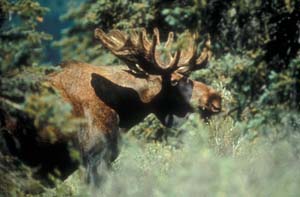A Laysan albatross named Wisdom is the oldest bird in the United States, and in North America, according to a US Geological Survey press release. The bird is at least 60 years old. It was banded while sitting on an egg in 1956, and was at that time estimated to be five years old. The bird was recently spotted at Midway Atoll National Wildlife Refuge. It has been spotted there several times in the last few years.
Category Archives: Alaska
Non-native tree kills moose in Alaska
 |
|
| US Fish & Wildlife Service |
Three moose in Anchorage, Alaska are dead after eating buds, branches or berries from European bird cherry trees (Prunus padus). In one case a moose ate branches that had been pruned in the fall and stored under a deck. One of the moose also ate a toxic amount of Japanese yew branches.
European bird cherry, also known as mayday tree, May Day tree, or hagberry, is considered invasive along streams in both Anchorage and Fairbanks, Alaska. The tree is native to northern Europe and closely resembles native chokecherry trees. In the two Alaskan cities, European bird cherry is changing the mix of plant species in riverside ecosystems. Typically, moose do not browse the tree, allowing the non-native tree to dominate the native species that the moose do eat. The tree has also naturalized in Illinois, New York, New Jersey, Pennsylvania, Delaware, Ontario, and New Brunswick
No one is sure why the moose ate the trees now, when they usually don’t, or why the trees proved so toxic, since the level of toxins in the tree can vary. The only unusual event noted was a mid-winter thaw.
For the full story in the Anchorage Daily News, click here.
For a PDF backgrounder on Prunus padus from the National Park Service, including lots of photos of flowers and fruits, click here, and get ready to download the file.
